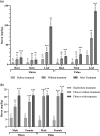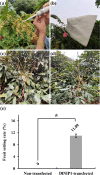Boron homeostasis affects Longan yield: a study of NIP and BOR boron transporter of two cultivars
- PMID: 38163908
- PMCID: PMC10759464
- DOI: 10.1186/s12870-023-04689-8
Boron homeostasis affects Longan yield: a study of NIP and BOR boron transporter of two cultivars
Abstract
Background: Essential micronutrient Boron (B) plays crucial roles in plant survival and reproduction but becomes toxic in higher quantities. Although plant cells have different B transport systems, B homeostasis is mainly maintained by two transporter protein families: B exporters (BOR) and nodulin-26-like intrinsic proteins (NIP). Their diversity and differential expression are responsible for varied B tolerance among plant varieties and species. Longan is a highly admired subtropical fruit with a rising market in China and beyond. In the present study, we cultured Shixia (SX) and Yiduo (YD), two differently characterized Longan cultivars, with foliar B spray. We analyzed their leaf physiology, fruit setting, B content, and boron transporter gene expression of various tissue samples. We also traced some of these genes' subcellular localization and overexpression effects.
Results: YD and SX foliage share similar microstructures, except the mesophyll cell wall thickness is double in YD. The B spray differently influenced their cellular constituents and growth regulators. Gene expression analysis showed reduced BOR genes expression and NIP genes differential spatiotemporal expression. Using green fluorescent protein, two high-expressing NIPs, NIP1 and NIP19, were found to translocate in the transformed tobacco leaves' cell membrane. NIPs transformation of SX pollen was confirmed using magnetic beads and quantified using a fluorescence microscope and polymerase chain reaction. An increased seed-setting rate was observed when YD was pollinated using these pollens. Between the DlNIP1 and DlNIP19 transformed SX pollen, the former germinated better with increasing B concentrations and, compared to naturally pollinated plants, had a better seed-setting rate in YD♀ × SX♂.
Conclusion: SX and YD Longan have different cell wall structures and react differently to foliar B spray, indicating distinct B tolerance and management. Two B transporter NIP genes were traced to localize in the plasma membrane. However, under high B concentrations, their differential expression resulted in differences in Jasmonic acid content, leading to differences in germination rate. Pollination of YD using these NIPs transformed SX pollen also showed NIP1 overexpression might overcome the unilateral cross incompatibility between YD♀ × SX♂ and can be used to increase Longan production.
Keywords: Borate; Boric acid; Crossbreed; Exporter; Spatiotemporal expression; Translocation.
© 2023. The Author(s).
Conflict of interest statement
The authors declare no competing interests.
Figures











Similar articles
-
Investigating the Mechanism of Unilateral Cross Incompatibility in Longan (Dimocarpus longan Lour.) Cultivars (Yiduo × Shixia).Front Plant Sci. 2022 Feb 11;12:821147. doi: 10.3389/fpls.2021.821147. eCollection 2021. Front Plant Sci. 2022. PMID: 35222456 Free PMC article.
-
Regulation, Diversity and Evolution of Boron Transporters in Plants.Plant Cell Physiol. 2021 Sep 24;62(4):590-599. doi: 10.1093/pcp/pcab025. Plant Cell Physiol. 2021. PMID: 33570563 Review.
-
Boron demanding tissues of Brassica napus express specific sets of functional Nodulin26-like Intrinsic Proteins and BOR1 transporters.Plant J. 2019 Oct;100(1):68-82. doi: 10.1111/tpj.14428. Epub 2019 Jul 15. Plant J. 2019. PMID: 31148338 Free PMC article.
-
Nodulin Intrinsic Protein 7;1 Is a Tapetal Boric Acid Channel Involved in Pollen Cell Wall Formation.Plant Physiol. 2018 Nov;178(3):1269-1283. doi: 10.1104/pp.18.00604. Epub 2018 Sep 28. Plant Physiol. 2018. PMID: 30266747 Free PMC article.
-
Boron transport in plants: co-ordinated regulation of transporters.Ann Bot. 2010 Jun;105(7):1103-8. doi: 10.1093/aob/mcq044. Epub 2010 Mar 12. Ann Bot. 2010. PMID: 20228086 Free PMC article. Review.
Cited by
-
Long-term changes in soil biological activity and other properties of raised beds in Longan orchards.PeerJ. 2024 Nov 6;12:e18396. doi: 10.7717/peerj.18396. eCollection 2024. PeerJ. 2024. PMID: 39677944 Free PMC article.
References
-
- Ozyigit II, Filiz E, Saracoglu IA, Karadeniz S. Exploration of two major boron transport genes BOR1 and NIP5;1 in the genomes of different plants. Biotechnol Biotechnol Equip. 2020;34(1):455–468. doi: 10.1080/13102818.2020.1773311. - DOI
-
- Qiu DL. Acta Hortic. Leuven: Acta Hortic; 2014. Longan production and research in China; pp. 39–46.
MeSH terms
Substances
Supplementary concepts
Grants and funding
- 2022A1515012271/Basic and Applied Basic Research Foundation of Guangdong Province
- 2022A1515012271/Basic and Applied Basic Research Foundation of Guangdong Province
- 2022A1515012271/Basic and Applied Basic Research Foundation of Guangdong Province
- 2022A1515012271/Basic and Applied Basic Research Foundation of Guangdong Province
- 2022A1515012271/Basic and Applied Basic Research Foundation of Guangdong Province
- 2022A1515012271/Basic and Applied Basic Research Foundation of Guangdong Province
- 2022A1515012271/Basic and Applied Basic Research Foundation of Guangdong Province
- 2022B0202070002/Special Project for Research and Development in Key areas of Guangdong Province
- 2022B0202070002/Special Project for Research and Development in Key areas of Guangdong Province
- 2022B0202070002/Special Project for Research and Development in Key areas of Guangdong Province
- 2022B0202070002/Special Project for Research and Development in Key areas of Guangdong Province
- 2022B0202070002/Special Project for Research and Development in Key areas of Guangdong Province
- 2022B0202070002/Special Project for Research and Development in Key areas of Guangdong Province
- 2022B0202070002/Special Project for Research and Development in Key areas of Guangdong Province
LinkOut - more resources
Full Text Sources
Research Materials

